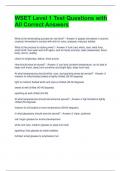WSET Level 1 Test Questions with
All Correct Answers
What is the winemaking process for red wine? - Answer ✔ grapes harvested in autumn,
crushed, fermented in contact with skin for color, pressed, matured, bottled
What is the process for tasting wine? - Answer ✔ look (red, white, rose, what hue),
smell (sniff, then swirl and sniff again, look for faulty aromas), taste (sweetness, flavor,
body, tannin, acidity)
check for brightness, debris, fresh aroma
How should wine be stored? - Answer ✔ cool and constant temperature, on its side to
keep cork moist, away from sunshine and bright light, away from heat
At what temperatures should white, rose, and sparking wines be served? - Answer ✔
medium to fulled bodied oaked at lightly chilled (50-55 degrees)
light to medium bodied white and rose at chilled (45-50 degrees)
sweet at well chilled (43-45 degrees)
sparkling at well chilled (43-50)
At what temperatures should red wines be served? - Answer ✔ light bodied at lightly
chilled (55 degrees)
medium to full bodied at room temperature (59-64 degrees)
In what glassware should wine be served? - Answer ✔ clean, polished
red: larger glasses for aroma development
white and rose: medium glasses to keep fruit fresh
sparkling: flute glasses to retain bubbles
fortified: small glasses to emphasize fruit
, How should light wine be opened? - Answer ✔ clean neck, draw cork gently, clean neck
inside and out
How should sparkling wine be opened? - Answer ✔ remove foil, loosen but keep cage
under thumb, tilt bottle at 30 degrees away, turn bottle, ease cork quietly out of bottle
How many glasses can be poured from a standard 75 cL bottle? - Answer ✔ 6 x 125 mL
glasses
4 x 175 mL glasses
3 x 250 mL glasses
How can wine be preserved? - Answer ✔ vacuum system (oxygen removed) or blanket
system (gas added)
What four areas control social responsibility of alcohol consumption? - Answer ✔ legal
age to purchase and legal age to drink
blood alcohol concentration
sensible drinking guidelines (1-2 alcohol free days a week, stop serving drunken
customer, etc.)
restrictions to marketing, packaging, and sale of alcohol
What are the standard drinks recommended? - Answer ✔ 1-2 x 12 mL a day for women
3 x 12 mL a day for men
do not exceed 4 x 12 mL
What is the chemical process for wine? - Answer ✔ Yeast feeds on the sugar in grape
juice, creating alcohol and carbon dioxide.
What are the three types of wine? - Answer ✔ light, sparkling, and fortified
What is light wine? - Answer ✔ 8-15% ABV, named by region or grape
What is sparkling wine? - Answer ✔ bubbles of carbon dioxide gas trapped in the wine
(ex: Champagne, cava, sekt, prosecco, etc.)
What is fortified wine? - Answer ✔ alcohol has been added, 15-22% ABV (ex: port,
sherry, etc.)
How is the color of wine determined? - Answer ✔ the type of grapes used (ex: white
wine made with white grapes, red wine made with red grapes) and/or the way the wine




